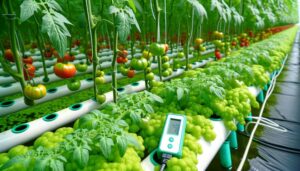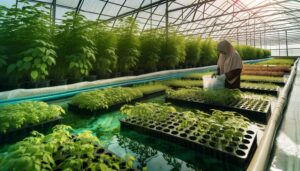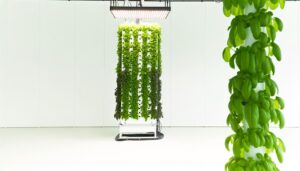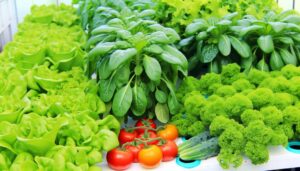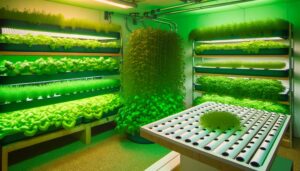What Is Hydroponics and How Does It Work
Hydroponics is a method we use to grow plants without soil, utilizing mineral nutrient solutions dissolved in water to directly deliver nutrients. We optimize growth by carefully controlling pH levels and ensuring adequate aeration to prevent root rot.
Inert mediums like perlite or coconut coir offer root support while maximizing nutrient uptake. Systems such as Deep Water Culture (DWC) and Nutrient Film Technique (NFT) tailor nutrient and oxygen delivery for different plant needs.
Reduced pest and disease issues make hydroponics a sustainable alternative to conventional farming. Explore further to understand the distinct advantages and setup requirements.

Key Takeaways
- Hydroponics grows plants without soil by using mineral nutrient solutions delivered directly in water.
- It involves controlled nutrient delivery, light, oxygen, and pH levels for optimal plant health.
- Inert mediums like perlite or coconut coir support plant roots while keeping them aerated and hydrated.
- Automated systems and sensors enhance nutrient efficiency and environmental control.
Definition of Hydroponics
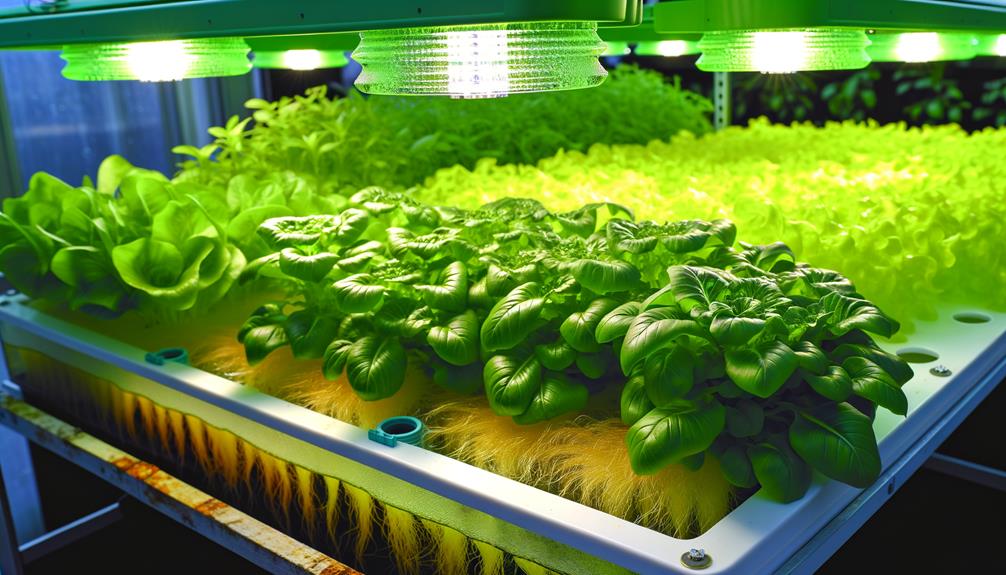
Hydroponics is a method of growing plants without soil by using mineral nutrient solutions in an aqueous solvent.
By eliminating soil, we can control nutrient delivery directly to the plant roots, enhancing growth conditions. This technique allows us to precisely regulate pH levels, nutrient concentration, and oxygenation, ensuring plants receive ideal conditions for development.
Hydroponic systems include various types, such as nutrient film technique (NFT), deep water culture (DWC), and aeroponics, each offering distinct advantages. By leveraging these technologies, we can achieve faster growth rates, higher yields, and efficient resource utilization.
The absence of soil also minimizes pest and disease issues, making hydroponics a compelling option for sustainable agriculture.
Let's explore how this innovative method can revolutionize modern farming.
History of Hydroponics
Let's explore hydroponics' evolution, starting with ancient civilizations' innovative techniques.
We'll then examine significant 20th-century breakthroughs that laid the groundwork for today's advancements.
This historical context will help us understand hydroponics' current and future potential.
Ancient Civilizations' Techniques
Ancient civilizations' ingenious use of hydroponic techniques underscores humanity's long-standing ingenuity in agricultural innovation. By examining historical practices, we can see how early societies harnessed these methods to optimize crop yield.
Remarkably, they developed:
- Hanging Gardens of Babylon: An early example of a hydroponic system, utilizing a series of terraces with water channels for plant nourishment.
- Aztec Chinampas: These 'floating gardens' used lake water to cultivate crops on rafts, demonstrating advanced understanding of aquatic agriculture.
- Egyptian Gardens: Egyptians grew crops in waterlogged soils along the Nile, effectively employing natural hydroponic principles.
These ancient techniques laid foundational principles that continue to inform modern hydroponics, showcasing the timeless quest for agricultural efficiency and innovation.
20th Century Innovations
Building on the foundational principles established by ancient civilizations, the 20th century witnessed remarkable advancements in hydroponic techniques that revolutionized modern agriculture.
We saw the development of nutrient film technique (NFT) and aeroponics, both of which optimized nutrient delivery and root oxygenation.
Hydroponics research stations were established globally, enhancing our understanding of plant physiology and nutrient uptake.
Synthetic nutrient solutions became more refined, allowing for precise control over plant growth conditions.
Innovations in controlled environment agriculture (CEA) integrated hydroponics with advanced climate control systems, maximizing yield and quality.
These breakthroughs have set the stage for hydroponics to become a viable alternative to traditional soil-based farming, addressing food security and sustainability challenges.
Modern-day Advancements
How have modern-day advancements in hydroponics further refined our ability to cultivate crops without soil, enhancing both efficiency and sustainability?
We've seen a revolution in technology and practices that have propelled the field forward. Key innovations include:
- Automated Systems: Integration of IoT devices and AI allows for precise monitoring and control of nutrient levels, pH, and environmental conditions.
- LED Grow Lights: Energy-efficient LED technology provides ideal light spectra for photosynthesis, reducing energy consumption.
- Vertical Farming: Utilizing vertical space in controlled environments maximizes yield per square foot, addressing urban agriculture needs.
These advancements not only streamline operations but also make hydroponic farming more accessible and scalable.
The future of agriculture is increasingly intertwined with these cutting-edge technologies, promising greater food security and sustainability.
Basic Principles
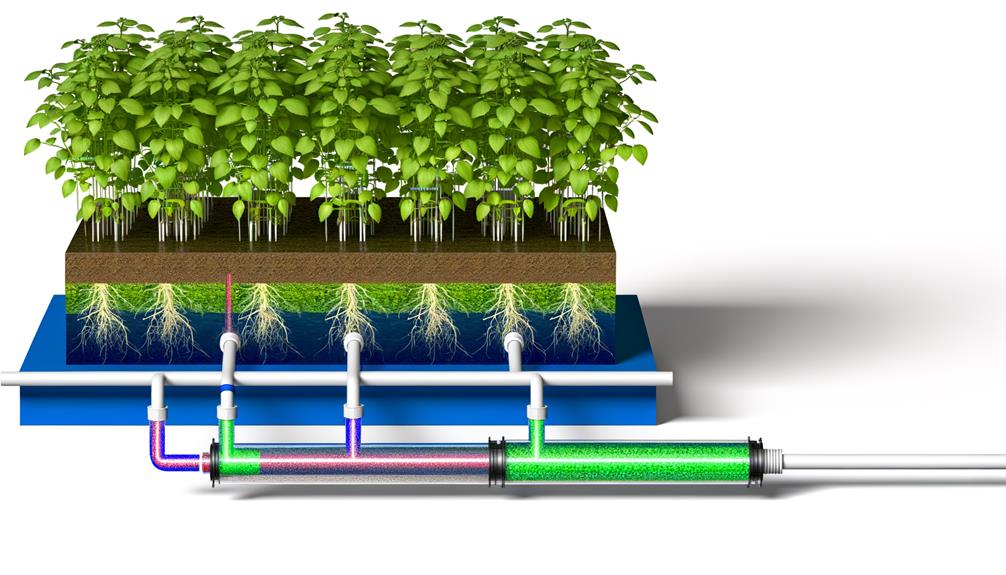
Understanding the basic principles of hydroponics is vital for enhancing plant growth and maximizing efficiency. First, we must recognize that hydroponics eliminates soil, instead using nutrient-rich water solutions. The key elements include water, light, oxygen, and nutrients. By precisely controlling these factors, we can enhance plant health and productivity.
Secondly, root support is important, often provided by inert mediums such as perlite or coconut coir. These mediums provide stability while allowing for ideal nutrient uptake.
Thirdly, the pH level of the nutrient solution needs careful monitoring and adjustment to maintain an ideal range, typically between 5.5 and 6.5, guaranteeing nutrient availability.
Lastly, we must guarantee consistent aeration to prevent root rot and promote robust growth.
Types of Hydroponic Systems
Now, let's examine the primary types of hydroponic systems: Deep Water Culture, Nutrient Film Technique, and Aeroponics.
Each system has unique characteristics and operational principles that affect plant growth efficiency.
We'll analyze how these methods manage nutrient delivery, oxygenation, and root support.
Deep Water Culture
Deep Water Culture (DWC) involves suspending plant roots in a nutrient-rich, oxygenated water solution, making it one of the simplest and most effective hydroponic systems available. This method offers several advantages for those of us seeking innovative agricultural techniques:
- Enhanced Oxygenation: Air pumps continuously supply oxygen to the roots, promoting faster growth and healthier plants.
- Simplified Maintenance: Unlike other systems, DWC requires minimal maintenance, making it ideal for both beginners and experienced growers.
- Cost-Effective Setup: The basic components—air pump, air stone, and nutrient solution—are relatively inexpensive, providing an accessible entry point into hydroponics.
Nutrient Film Technique
The Nutrient Film Technique (NFT) involves a thin, continuous flow of nutrient-rich water over plant roots, allowing for efficient nutrient uptake and oxygenation.
We position plants in channels with a slight tilt, ensuring gravity aids the water flow. This system maximizes root exposure to nutrients and oxygen, promoting rapid growth and high yields.
With NFT, we can monitor and adjust nutrient concentrations easily, ensuring favorable conditions for plant health. The minimal water usage and absence of growing medium make NFT an eco-friendly and cost-effective choice.
However, the system requires precise control and regular maintenance to prevent pump failures and nutrient imbalances.
NFT is ideal for leafy greens and herbs but may not support larger, fruit-bearing plants effectively.
Aeroponics Explained
Aeroponics, by suspending plant roots in air and misting them with nutrient-rich solutions, offers an innovative approach to hydroponic systems. This technique maximizes oxygen exposure to the roots, promoting faster growth and higher yields.
Let's explore the key advantages:
- Efficiency: By delivering nutrients directly to the roots, aeroponics minimizes water and nutrient waste.
- Flexibility: Systems can be easily adjusted to optimize nutrient delivery based on plant growth stages.
- Disease Control: With roots exposed to air, there's a reduced risk of soil-borne diseases and pests.
We're pushing the boundaries of traditional agriculture with aeroponics. It's a method that promises higher productivity and sustainable farming solutions, catering to our need for innovation in food production.
Nutrient Solutions
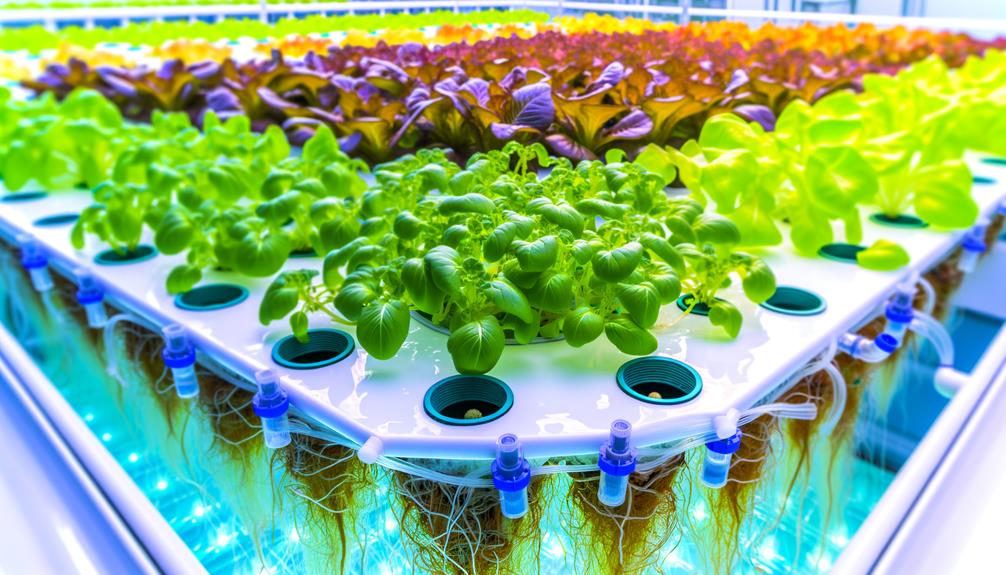
Nutrient solutions form the backbone of hydroponic systems by delivering essential minerals and nutrients directly to plant roots.
We precisely tailor these solutions to meet the specific needs of each plant species. By adjusting the concentration of macronutrients like nitrogen, phosphorus, and potassium, along with micronutrients such as iron, manganese, and zinc, we optimize plant health and growth rates.
The pH of the solution is critical; a range of 5.5 to 6.5 guarantees nutrient availability. Advanced systems use sensors and automated dosing to maintain ideal conditions, reducing human error and increasing efficiency.
This precision allows us to grow healthier plants faster, making hydroponics a revolutionary method in modern agriculture.
Growth Mediums
Let's explore the various growth mediums commonly used in hydroponics and their specific advantages and disadvantages.
We'll compare mediums like rock wool, coconut coir, and clay pellets to understand their impact on root support and nutrient delivery.
This analysis will help us determine the most effective medium for different types of hydroponic systems.
Popular Growth Mediums
In hydroponics, selecting the appropriate growth medium is essential for optimizing plant health and productivity. We need growth mediums that guarantee proper root aeration, water retention, and nutrient delivery.
Here are three popular growth mediums:
- Rockwool: Made from spun molten rock, it offers excellent water retention and aeration, making it ideal for germination and cloning.
- Coco Coir: Derived from coconut husks, this medium provides a balanced air-to-water ratio and is highly sustainable.
- Clay Pellets: Also known as hydroton, these pellets ensure robust root development due to their excellent aeration properties and reusability.
Mediums' Benefits and Drawbacks
Each growth medium in hydroponics presents unique benefits and drawbacks that directly impact plant health and system efficiency. Let's analyze a few common options.
| Medium | Benefits | Drawbacks |
|---|---|---|
| Rockwool | Excellent water retention, sterile | pH instability, non-biodegradable |
| Coconut Coir | Sustainable, good aeration | Requires buffering, can compact |
| Clay Pellets | Reusable, pH neutral | Expensive, poor water retention |
Rockwool excels in water retention but needs pH monitoring and isn't eco-friendly. Coconut coir is sustainable and aerated, yet it requires buffering and can compact over time. Clay pellets offer reusability and pH neutrality but come with high costs and subpar water retention. By understanding these trade-offs, we can optimize our hydroponic systems for better yield and efficiency.
Benefits of Hydroponics

Hydroponics offers numerous advantages, including faster plant growth, higher yields, and more efficient use of water and nutrients.
Let's examine these benefits:
- Accelerated Growth Rates: By optimizing the delivery of nutrients and maintaining controlled environmental conditions, we can achieve growth rates up to 50% faster than traditional soil methods.
- Increased Yields: Hydroponic systems maximize space utilization and plant density, resulting in substantially higher yields per unit area.
- Water Efficiency: Hydroponics uses up to 90% less water than conventional farming, thanks to recirculation and targeted nutrient delivery.
These benefits make hydroponics a compelling choice for sustainable and innovative agricultural practices.
Challenges and Solutions
While hydroponics offers significant advantages, we must also address several challenges to fully harness its potential.
Nutrient imbalances can occur, requiring precise monitoring and adjustments. Pathogen control is critical, as waterborne diseases can spread rapidly. We need to guarantee proper oxygenation of the root zone to prevent root rot.
Energy consumption is another concern, especially for indoor systems relying on artificial lighting. Additionally, initial setup costs can be high, necessitating a clear return on investment strategy.
To mitigate these issues, we can use advanced sensors for real-time nutrient and pH monitoring, adopt UV sterilization for pathogen control, and integrate renewable energy sources.
Setting Up a Hydroponic System
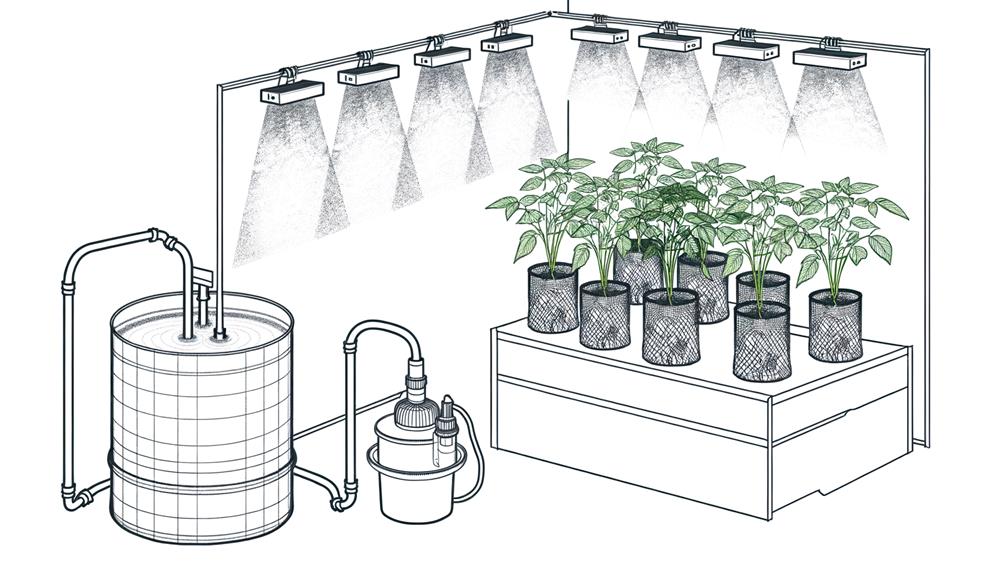
To set up a hydroponic system, we must first select an appropriate growing medium and container that suit the specific plants we intend to cultivate. Confirming these components are ideal fosters efficient nutrient uptake and plant growth.
Next, we need to:
- Install a water reservoir: This holds the nutrient solution and must be adequately sized for our system's scale.
- Set up a pump and irrigation system: This guarantees the nutrient-rich water circulates effectively, maintaining consistent nutrient delivery to the plants.
- Monitor pH and nutrient levels: Using precise sensors, we can maintain the ideal conditions for plant health and productivity.
Common Plants for Hydroponics
Many plants thrive in hydroponic systems, with leafy greens, herbs, and certain fruiting vegetables being particularly well-suited for this method of cultivation.
Lettuce, spinach, and kale grow rapidly due to the optimized nutrient uptake.
Herbs such as basil, mint, and oregano benefit from controlled environments, producing higher yields.
Fruiting vegetables like tomatoes, cucumbers, and peppers also perform well, given their nutrient and water needs are precisely met.
Root vegetables, however, often pose challenges due to their growth patterns and space requirements.
Selecting plants with high water and nutrient demands enhances system efficiency.
Future of Hydroponics
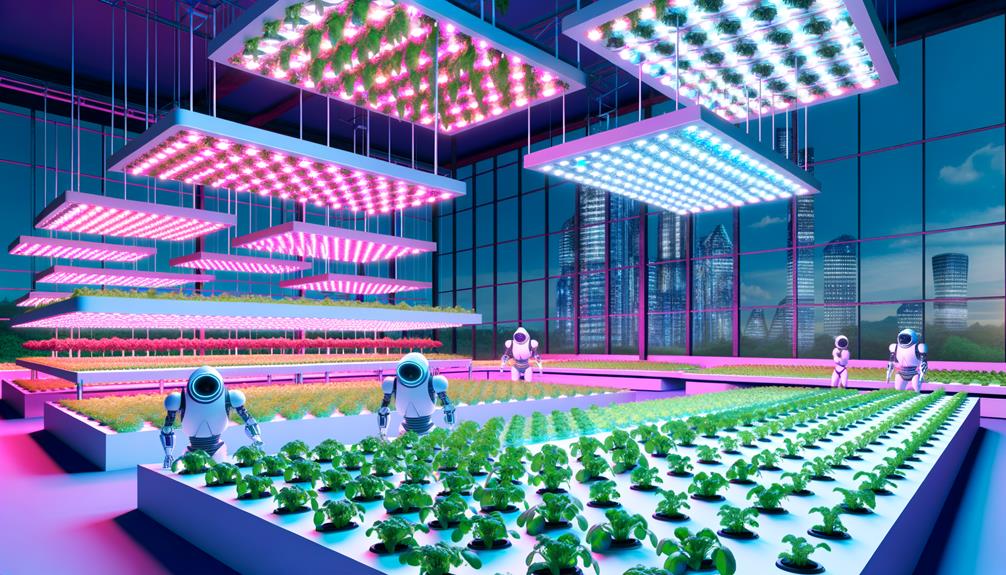
The future of hydroponics promises significant advancements in sustainable agriculture and food production efficiency.
As we look ahead, three key developments stand out:
- Automation and AI Integration: Leveraging artificial intelligence for real-time monitoring and automated nutrient delivery systems will optimize growth conditions and reduce labor costs.
- Vertical Farming Revolution: Expanding vertically in urban environments will maximize space utilization and bring fresh produce closer to consumers, reducing transportation emissions.
- Enhanced Nutrient Solutions: Innovations in nutrient formulations will further enhance plant growth rates and nutritional content, making hydroponically-grown food even more appealing.
Conclusion
In exploring hydroponics, we've navigated through its definition, historical roots, and core principles.
We've dissected various systems, nutrient solutions, and tackled challenges head-on.
Setting up a hydroponic system might seem intimidating, but it's a rewarding endeavor.
Picture lush, thriving plants, unbound by soil, reaching for the stars.
The future of hydroponics promises boundless potential, revolutionizing how we grow our food.
Let's embrace this green revolution and cultivate a more sustainable tomorrow.

